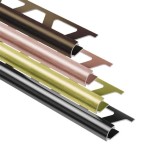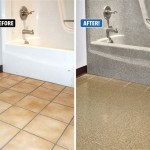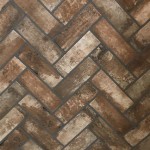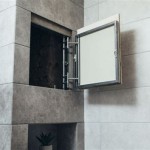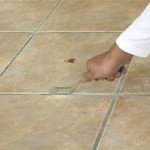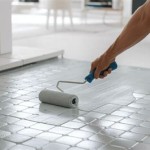How To Clean Bathroom Tiles Easily
Maintaining clean bathroom tiles is crucial for hygiene, aesthetics, and the overall longevity of your bathroom. Accumulation of soap scum, mildew, and hard water stains can make the tiles look dull and unsightly, potentially leading to more significant problems if left unattended. This article provides a comprehensive guide on how to effectively and easily clean bathroom tiles, covering various cleaning methods and preventative measures to keep your bathroom sparkling.
Understanding the Types of Bathroom Tile and Common Issues
Before embarking on the cleaning process, it's important to understand the different types of bathroom tiles commonly used. Ceramic tiles are one of the most popular options due to their durability, water resistance, and ease of cleaning. Porcelain tiles, similar to ceramic, are even denser and more impervious to water, making them ideal for high-moisture areas. Natural stone tiles, such as marble, granite, and slate, offer a luxurious look but require more specialized care due to their porous nature.
Grout, the material filling the gaps between tiles, is particularly susceptible to staining and mildew growth. Its porous surface readily absorbs moisture and spills, creating a breeding ground for bacteria and mold. Understanding these tile types and the common problems associated with them helps inform the choice of appropriate cleaning methods and products.
The most prevalent issues encountered with bathroom tiles are soap scum buildup, hard water stains, and mildew or mold growth. Soap scum forms from the reaction of soap with hard water minerals, creating a sticky residue that adheres to tile surfaces. Hard water stains result from mineral deposits left behind when water evaporates, leaving unsightly white or grayish marks. Mildew and mold thrive in damp, poorly ventilated environments, manifesting as dark, slimy patches on tiles and grout.
Essential Cleaning Supplies and Tools
Having the right supplies and tools on hand can significantly simplify the tile cleaning process. Essential items include:
*Cleaning solutions:
Options range from commercial tile cleaners to DIY solutions like white vinegar, baking soda, and dish soap. The choice depends on the type of tile and the severity of the staining. *Spray bottle:
For applying cleaning solutions evenly. *Scrub brush:
A stiff-bristled brush is necessary for scrubbing grout lines and removing stubborn stains. Grout brushes are specifically designed for this purpose. *Sponges:
For wiping down tile surfaces and applying cleaning solutions. *Microfiber cloths:
For drying tiles and polishing surfaces after cleaning. *Squeegee:
For removing excess water from shower tiles to prevent water spots and mildew growth. *Gloves:
To protect hands from harsh chemicals and bacteria. *Eye protection:
Especially when using strong cleaning agents. *Old toothbrush:
Useful for reaching tight corners and small areas.For more challenging cleaning tasks, consider using a steam cleaner. Steam cleaners use hot steam to loosen dirt and grime without the need for harsh chemicals, making them particularly effective for sanitizing grout lines and removing stubborn stains.
Step-by-Step Cleaning Methods for Bathroom Tiles
The following are effective methods for cleaning bathroom tiles, catering to different levels of grime and stain severity:
1. Basic Cleaning with Mild Detergent:
This method is suitable for routine cleaning and removing light soap scum buildup. Mix a few drops of mild dish soap with warm water in a bucket. Using a sponge or cloth, apply the solution to the tile surfaces, paying attention to grout lines. Allow the solution to sit for a few minutes to loosen any dirt or grime. Scrub the tiles and grout with a scrub brush or sponge. Rinse thoroughly with clean water and dry with a microfiber cloth or squeegee.
2. Cleaning with White Vinegar:
White vinegar is a versatile natural cleaner that effectively removes hard water stains and mild mildew. Mix equal parts white vinegar and water in a spray bottle. Spray the solution onto the tiles and let it sit for 10-15 minutes. Scrub the tiles and grout with a scrub brush. Rinse thoroughly with clean water and dry with a microfiber cloth.
For stubborn stains, heat the vinegar slightly before mixing it with water. However, avoid using vinegar on natural stone tiles like marble, as its acidity can damage the surface.
3. Cleaning with Baking Soda Paste:
Baking soda is a mild abrasive that can remove stubborn stains without scratching tile surfaces. Make a paste by mixing baking soda with a small amount of water. Apply the paste to the stained areas and let it sit for 10-15 minutes. Scrub the tiles and grout with a scrub brush or sponge. Rinse thoroughly with clean water and dry with a microfiber cloth.
For grout cleaning, mix baking soda with hydrogen peroxide to create a more potent cleaning paste. Apply the paste to the grout lines, let it sit for a few minutes, scrub, and rinse.
4. Using Commercial Tile Cleaners:
Commercial tile cleaners are formulated to tackle specific types of stains and grime. When using commercial cleaners, always follow the manufacturer's instructions carefully. Wear gloves and eye protection to avoid skin and eye irritation. Ensure proper ventilation while using these products.
Choose a cleaner that is appropriate for the type of tile you have. Some cleaners are specifically designed for ceramic and porcelain tiles, while others are formulated for natural stone tiles. Avoid using abrasive cleaners on delicate surfaces.
5. Addressing Mold and Mildew:
Mold and mildew require a more aggressive approach. Mix bleach with water in a 1:10 ratio (1 part bleach to 10 parts water). Spray the solution onto the affected areas, let it sit for 10-15 minutes, and scrub with a scrub brush. Rinse thoroughly with clean water. Ensure adequate ventilation during and after the cleaning process.
Alternatively, use a commercially available mold and mildew remover. Always follow the product's instructions and safety precautions. For severe mold infestations, it may be necessary to consult a professional mold remediation service.
6. Steam Cleaning:
Steam cleaning is an effective and eco-friendly way to clean bathroom tiles and grout. The high-temperature steam loosens dirt, grime, and kills bacteria and mold without the need for harsh chemicals. Follow the manufacturer's instructions for operating the steam cleaner. Use the appropriate nozzle attachment for cleaning tile surfaces and grout lines. Move the steam cleaner slowly and steadily over the tiles, allowing the steam to penetrate and loosen the dirt. Wipe the tiles with a clean cloth after steam cleaning.
Preventative Measures for Maintaining Clean Bathroom Tiles
Preventing the buildup of soap scum, hard water stains, and mildew is key to maintaining clean bathroom tiles. Implementing the following preventative measures can significantly reduce the frequency and intensity of cleaning required:
*Ventilation:
Ensure proper ventilation in the bathroom by opening windows or using an exhaust fan during and after showering. This helps to reduce humidity and prevent mildew growth. *Squeegeeing:
Use a squeegee to remove excess water from shower tiles after each use. This prevents water spots and soap scum buildup. *Regular Wiping:
Wipe down the shower walls and tiles with a clean cloth after showering to remove excess water and soap residue. *Using Liquid Soap:
Liquid soaps tend to create less soap scum compared to bar soaps. Consider switching to liquid soap or using soap-free shower gels. *Water Softener:
If the water in your area is hard, consider installing a water softener to reduce mineral deposits on tiles and fixtures. *Sealing Grout:
Seal grout lines with a grout sealant to prevent water and dirt from penetrating. Reapply sealant every 1-2 years, or as needed. *Regular Cleaning Schedule:
Establish a regular cleaning schedule to prevent dirt and grime from accumulating. A quick wipe-down once a week can prevent the need for more intensive cleaning later.Specific Considerations for Different Tile Types
Different types of bathroom tiles require specific cleaning considerations to avoid damage and maintain their appearance. Natural stone tiles, such as marble and granite, are particularly sensitive to acidic cleaners. Avoid using vinegar, lemon juice, or abrasive cleaners on these tiles. Instead, use a pH-neutral cleaner specifically designed for natural stone. Regularly seal natural stone tiles to prevent staining and water damage.
For ceramic and porcelain tiles, a wider range of cleaning products can be used. However, avoid using highly abrasive cleaners that can scratch the surface of the tile. Grout can be cleaned with a variety of methods, including baking soda paste, vinegar, or commercial grout cleaners. When cleaning grout, use a grout brush to effectively scrub the grout lines.
When dealing with textured tiles, pay special attention to cleaning the grooves and crevices. A scrub brush or toothbrush can be helpful for reaching these areas. Rinse thoroughly to remove any cleaning residue.
Troubleshooting Common Tile Cleaning Problems
Even with the best cleaning methods, some stubborn stains and grime may persist. Here are solutions to common tile cleaning problems:
*Stubborn Soap Scum:
For stubborn soap scum, try using a commercial soap scum remover or a paste made from baking soda and water. Let the solution sit on the soap scum for a longer period before scrubbing. *Hard Water Stains:
Hard water stains can be removed with white vinegar or a commercial hard water stain remover. For severe stains, try using a pumice stone to gently scrub the affected area. Be careful not to scratch the tile surface. *Mold and Mildew:
For persistent mold and mildew, try using a stronger bleach solution or a commercial mold and mildew remover. Ensure proper ventilation and wear protective gear. *Stained Grout:
If grout remains stained after cleaning, consider using a grout stain remover or a grout whitener. These products are designed to penetrate and remove stains from grout lines. *Damaged Tiles:
If tiles are cracked or damaged, it may be necessary to replace them. Consult a professional tile installer for assistance.By following these steps and implementing preventative measures, maintaining clean bathroom tiles becomes a manageable and efficient task, contributing to a healthier and more aesthetically pleasing bathroom environment.

7 Most Powerful Ways To Clean Tiles Grout Naturally

How To Clean Bathroom Tiles At Home

How To Clean Bathroom Tile Grout Home Remedies Banish Mould Express Co

How To Clean Bathroom Tiles With Baking Soda Mygate

4 Bathroom Tile Cleaning Tips Slique

Best Way To Clean Bathroom Tiles

How To Clean Bathroom Tiles Fantastic Services

How To Clean Bathroom Tiles Toilets And Showers Wd 40

How To Clean Bathroom Tiles 7 Tips Tricks You Can Use

How To Clean A Shower And Keep It That Way Diy Recipes Mama
Related Posts

